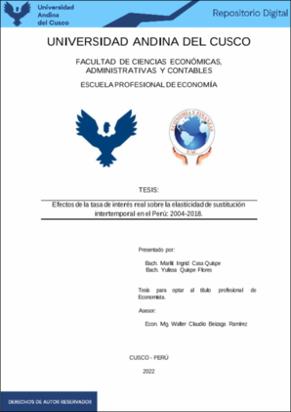| dc.contributor.advisor | Beizaga Ramírez, Walter Claudio | |
| dc.contributor.author | Casa Quispe, Marlit Ingrid | |
| dc.contributor.author | Quispe Flores, Yulissa | |
| dc.date.accessioned | 2023-03-27T17:25:06Z | |
| dc.date.available | 2023-03-27T17:25:06Z | |
| dc.date.issued | 2022-10-17 | |
| dc.identifier.uri | https://hdl.handle.net/20.500.12557/5236 | |
| dc.description.abstract | La elasticidad de sustitución intertemporal (IES) es un parámetro clave que caracteriza el
comportamiento de ahorro y consumo de los hogares, y juega un papel crucial en la literatura
macroeconómica y la determinación de las evaluaciones de política y bienestar de los
gobiernos de todo el mundo. A pesar de su importancia en la determinación de indicadores
macroeconómicos, se han identificado dificultades econométricas tales como la agregación
temporal, la identificación débil y la heterogeneidad entre los consumidores que ha hecho
difícil su correcta aproximación empírica. El presente estudio aprovecha la variación del
Impuesto al Valor Agregado en Perú de 19% a 18% el año 2011, esta variación proporciona
una ventana de 6 años antes y después para estimar la elasticidad de sustitución intertempo ra l
utilizando un modelo de regresión para el período de estudio. Se hace uso de la Encuesta
Nacional de Hogares para el período 2004-2018. se utiliza información de series de tiempo
del Banco Central de Reserva del Perú. Los resultados encuentran que la elasticidad de
sustitución intertemporal no fue elástica a cambios en la tasa de interés real en el Perú para
bienes duraderos y no duraderos durante el período 2004-2018. Se estima una EIS de 0.25.
Este resultado indica que el motivo de suavización del consumo de los hogares es fuerte y,
debido a esto, los consumidores ahorrarán poco y consumirán mucho. Asimismo, se
identifican efectos estadísticamente significativos para la relación entre en el ahorro y el
crédito, la inflación y la deuda pública durante el período de estudio. | es_PE |
| dc.description.abstract | The intertemporal elasticity of substitution (IES) is a key parameter that characterizes the
saving and consumption behavior of households, and plays a crucial role in the
macroeconomic literature and the determination of the policy and welfare assessments of
governments around the world. . Despite its importance in determining macroeconomic
indicators, econometric difficulties such as temporal aggregation, weak identification and
heterogeneity among consumers have been identified, which has made its correct empirica l
approximation difficult. This study takes advantage of the variation of the Value Added Tax
in Peru from 19% to 18% in 2011, this variation provides a window of 6 years before and
after to estimate the intertemporal elasticity of substitution using a regression model for the
period of study. The National Household Survey is used for the period 2004-2018. Time
series information from the Central Reserve Bank of Peru is used. The results find that the
intertemporal elasticity of substitution was not elastic to changes in the real interest rate in
Peru for durable and non-durable goods during the 2004-2018 period. An EIS of 0.25 is
estimated. This result indicates that the reason for the smoothing of household consumptio n
is strong and, because of this, consumers will save little and consume a lot. Likewise,
statistically significant effects are identified for the relationship between savings and credit,
inflation and public debt during the study period. | en_US |
| dc.format | application/pdf | es_PE |
| dc.language.iso | spa | es_PE |
| dc.publisher | Universidad Andina del Cusco | es_PE |
| dc.rights | info:eu-repo/semantics/restrictedAccess | es_PE |
| dc.rights.uri | https://creativecommons.org/licenses/by-nc-nd/4.0/ | es_PE |
| dc.subject | Tasa de interés real | es_PE |
| dc.subject | Elasticidad de sustitución intertemporal | es_PE |
| dc.title | Efectos de la tasa de interés real sobre la elasticidad de sustitución intertemporal en el Perú: 2004-2018 | es_PE |
| dc.type | info:eu-repo/semantics/bachelorThesis | es_PE |
| thesis.degree.name | Economista | es_PE |
| thesis.degree.grantor | Universidad Andina del Cusco. Facultad de Ciencias Económicas, Administrativas y Contables | es_PE |
| thesis.degree.discipline | Economía | es_PE |
| dc.publisher.country | PE | es_PE |
| dc.subject.ocde | https://purl.org/pe-repo/ocde/ford#5.02.01 | es_PE |
| renati.advisor.dni | 23821642 | |
| renati.advisor.orcid | https://orcid.org/0000-0001-9232-2063 | es_PE |
| renati.author.dni | 70380263 | |
| renati.author.dni | 72948808 | |
| renati.discipline | 311016 | es_PE |
| renati.juror | Paullo Tisoc, Rocio | |
| renati.juror | Quispe Palomino, Alberto | |
| renati.juror | Fuentes Gamboa, Jeny Lady | |
| renati.juror | Delgado Candia, Sonia Sofia | |
| renati.level | https://purl.org/pe-repo/renati/level#tituloProfesional | es_PE |
| renati.type | https://purl.org/pe-repo/renati/type#tesis | es_PE |



